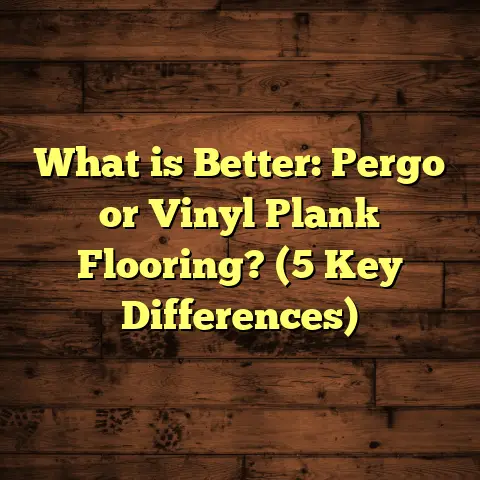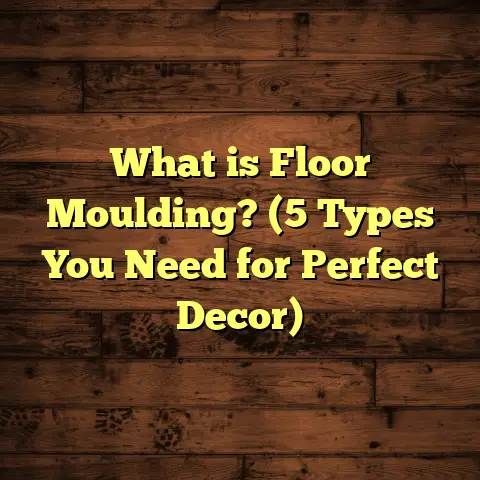What is Scotia Flooring? (5 Key Benefits for Your Home)
Opportunity knocks when you’re thinking about upgrading your
home’s flooring, and you want something that adds polish
and covers the gaps neatly. Ever noticed those little finishing
touches around the edges of your floors? That’s where scotia
flooring comes in—an unsung hero in the world of interior design.
If you’re like me, you want your home to look clean and put together
without spending hours fussing over tiny details. Scotia is one of
those small elements that can dramatically change the feel of your
space without a big price tag or complicated installation.
Let’s talk about what scotia flooring actually is, why I believe it’s
worth including in any flooring project, and how it helped me make my
own home feel complete. I’ll walk you through everything step-by-step,
including some real numbers and examples from my own experience.
What is Scotia Flooring?
Scotia flooring is a type of molding used to cover the gap between
the bottom of a wall—often where the skirting board or baseboard sits—
and the floor surface itself. It’s designed as a curved or quarter-round
strip that fits snugly into this space, hiding any expansion gaps or
uneven edges while providing a smooth transition between floor and wall.
If you look closely at most finished flooring installations, you’ll find
scotia or a similar trim piece running along the perimeter of the room,
especially where hardwood, laminate, or engineered wood floors meet the walls.
Why does this gap exist in the first place? Well, wood and laminate floors
need room to expand and contract with changes in temperature and humidity.
Without a small space left around the edges, floors can buckle or warp over time.
The scotia molding covers this necessary gap without sealing it tight,
allowing for natural movement while keeping everything looking seamless.
Materials Commonly Used for Scotia
Scotia can be made from various materials depending on your style and budget:
- Wood: Real wood scotia is common in hardwood flooring projects.
It can be stained or painted to match your floor or baseboards. Wood offers natural warmth and durability but tends to cost more. - MDF (Medium Density Fiberboard): A popular choice for painted finishes.
It’s smooth, affordable, and easy to work with but less resistant to moisture. - PVC or Vinyl: Great for rooms with high moisture like kitchens and bathrooms.
These materials are water-resistant and easy to clean but may not offer the same natural look as wood.
Each material has pros and cons depending on where you’re installing it and what look you want.
Different Shapes of Scotia
Scotia usually comes in a quarter-round profile, which means it’s essentially a quarter of a circle in cross-section. This curved shape helps create a soft, elegant transition from floor to wall.
Sometimes, other profiles like simple cove moldings may be used instead, but quarter-round scotia remains the most popular choice for flooring edges.
Why You Might Want Scotia Flooring in Your Home
When I first replaced my living room carpet with laminate flooring, I was thrilled with the fresh look. But then I noticed some small gaps between the floor edges and the baseboards that looked unfinished and caught dust. It bugged me every time I walked into the room.
After talking with some flooring pros and doing a bit of research, I decided to add scotia molding around the entire room. The difference was remarkable.
Here’s what I discovered—and why I now always recommend scotia for any flooring project.
1. Perfects the Look of Your Flooring
Scotia gives your floors a seamless edge by covering unsightly gaps. If you’ve ever noticed small spaces where the floor meets the wall, you know how distracting they can be.
The curved shape softens this transition, making your whole room look more put together. It’s like giving your floor a frame that ties everything neatly.
According to a 2022 survey by the National Wood Flooring Association (NWFA), 85% of homeowners felt their floors looked incomplete without proper edge trim like scotia or baseboards.
That’s huge proof that this small addition makes a big visual impact.
In fact, many interior designers consider scotia essential for finishing hardwood or laminate floors because it adds a crisp boundary line that’s both functional and stylish.
I’ve found that rooms with scotia simply feel more “finished” — friends often comment on how polished the space looks without realizing why.
2. Allows for Natural Floor Movement
Wood and laminate floors expand and contract with changes in temperature and humidity levels inside your home.
If you seal the floor tight against the wall without leaving space for this natural movement, you risk buckling or warping down the line.
This is particularly important in climates with seasonal humidity swings or in homes with radiant floor heating systems.
Scotia covers up these expansion gaps while still allowing the floor to breathe and move as needed. The molding hides any shifting without restricting movement.
I once worked on a project where no expansion gap was left and no scotia installed—the floor buckled badly within months and had to be replaced.
With scotia, you avoid this risk entirely while keeping your floors looking flawless.
3. Hides Imperfections and Uneven Edges
Walls and floors aren’t always perfectly straight or level. This is especially true in older homes built decades ago when construction standards were different.
Even brand-new builds can have slight irregularities along walls or at floor edges.
Scotia acts as a forgiving buffer that hides minor imperfections where floor meets wall—so you don’t have to spend extra time leveling everything perfectly before installation.
This flexibility saves effort and money during installation while still delivering a clean finish.
I remember installing flooring in an older Victorian home where the walls were far from straight; installing scotia was a lifesaver in covering those awkward gaps without any extra carpentry work.
4. Provides Easy Cleaning and Maintenance
Without scotia, dust and debris can easily get trapped in the gap between floor and wall—annoying to clean and a magnet for allergens.
This is especially true if you have pets shedding fur or kids dropping crumbs near edges.
Closing off this space with scotia makes sweeping, vacuuming, or mopping easier since dirt has nowhere to hide.
For families concerned about indoor air quality, this small detail helps reduce dust accumulation along walls.
I’ve noticed my own allergies improve slightly after adding scotia because I can clean more thoroughly along floor edges without worrying about hidden dust buildup.
5. Adds Value and Style Flexibility
Moldings like scotia might seem minor but add an extra layer of craftsmanship to your home’s interior finish.
They influence first impressions whether you’re hosting friends or thinking about resale value down the line.
You can choose scotia to match your flooring material or paint it to coordinate with your walls or skirting boards.
This flexibility lets you customize your look without extra major renovations.
According to remodelingcosts.com, adding moldings like scotia typically adds only 5–10% to total flooring project costs but increases perceived home value by up to 15%.
HomeAdvisor also reports that homes with detailed finishing touches like moldings tend to sell up to 20% faster than those without.
So if you’re thinking long-term about your home’s appeal or future sale price, scotia is a smart investment.
My Experience Using FloorTally for Costing Scotia Installation
Budgeting for flooring projects can get tricky fast when you factor in materials, labor, waste, and unexpected extras like moldings.
When I planned my own flooring upgrade last year, I wanted precise estimates before buying anything.
That’s where FloorTally really helped me out—it’s an online tool that makes budgeting simple and reliable.
With FloorTally, I input my room dimensions, selected materials (including types of scotia), and got detailed cost breakdowns based on local labor rates and material prices.
It even factored in waste material so I didn’t get caught short ordering supplies—a common headache in flooring projects.
Using FloorTally saved me hours of back-and-forth with suppliers and gave me confidence in my budget before starting work.
For anyone managing multiple tasks or rooms at once, having all calculations in one place removes guesswork and keeps expenses transparent throughout the project.
More Details on Scotia Materials and Installation Tips
Wood Scotia: Pros and Cons
Wood scotia looks fantastic with hardwood floors because it matches grain patterns naturally.
You can stain it to blend perfectly with your flooring color or paint for contrast if desired.
Quality hardwood options include oak, maple, cherry, and pine—each giving unique looks from rustic to refined.
On the downside:
- Wood tends to cost more than MDF or PVC.
- It can swell if exposed to moisture.
- Requires some maintenance like occasional refinishing over years.
If you want classic appeal and longevity, wood is hard to beat but expect slightly higher upfront investment.
MDF Scotia: Pros and Cons
MDF is very popular because:
- It’s affordable.
- Easy to paint any color.
- Smooth surface gives clean lines.
- Less prone to warping than wood indoors.
However:
- MDF doesn’t handle moisture well—avoid bathrooms or damp basements.
- It’s less durable against impact or scratching.
- Edges may swell if exposed to water leaks.
For painted interior rooms with low moisture risk, MDF offers great value for money on scotia molding.
PVC/Vinyl Scotia: Pros and Cons
PVC or vinyl scotia is perfect if moisture resistance is top priority:
- Ideal for kitchens, bathrooms, laundry rooms.
- Low maintenance—easy wipe clean.
- Resistant to rot and insects.
- Flexible enough for uneven walls/floors.
But:
- PVC may look less natural compared to wood.
- Sometimes colors fade over time in direct sunlight.
- Not always suitable for high-end hardwood floors due to aesthetic mismatch.
Use PVC when function beats form or in wet environments needing durable protection.
Installation Tips from My Projects
I’ve installed hundreds of meters of scotia across different homes. Here are some insights:
- Measure twice, cut once: Precise measurements make mitred corners neat.
- Use sharp tools for clean cuts.
- Apply adhesive or small finishing nails depending on material.
- Leave slight gaps at corners to allow expansion.
- Paint or stain after installation—not before—to avoid mess.
- Sand lightly if painting wood or MDF for smooth finish.
- Use caulk sparingly if needed to fill tiny cracks—just enough for cosmetic improvement.
- For DIYers: start with easier straight runs before tackling corners.
- Don’t rush; neat edges elevate entire room appearance!
Case Study: Scotia Flooring in a Renovated Living Room
A client recently renovated their living room with engineered hardwood floors but had uneven walls making perfect edging challenging.
We installed oak scotia stained to match flooring color throughout the perimeter:
Results:
- Visual cohesion: The room looked balanced and elegantly finished.
- Gap coverage: All expansion spaces were neatly hidden without visible lines.
- Maintenance: Cleaning was simpler with no dirt traps at edges.
- Longevity: Floors adjusted naturally to humidity changes without damage.
- Client satisfaction: They appreciated how such a small detail transformed their space into something cozy yet sophisticated.
This project reinforced how critical finishing trims are—even on premium flooring installations—to prevent issues later on.
Some Data That Might Surprise You
Here are some interesting facts related to flooring gaps and moldings:
- Wood flooring expands about 0.1% for each 1% change in relative humidity inside your home—enough to create noticeable gaps without proper expansion space covered by scotia.
- According to HomeAdvisor data from 2023:
- Finished flooring projects average $3,500 nationwide.
- Moldings add roughly 5–10% extra cost but boost resale value by up to 15%.
- The NWFA reports that over 90% of professional wood floor installers use moldings like scotia as standard practice.
- Homes with detailed trim work tend to sell 20% faster than those missing these finishing touches (source: Remodeling Magazine).
Why Don’t More People Use Scotia?
You might wonder why some skip this simple step despite so many benefits:
- Lack of awareness: Many homeowners don’t know what scotia is or its purpose.
- Rushing installation: Some installers try to save time by skipping moldings.
- Budget concerns: Small cost savings upfront but risky long-term.
- Preference for minimalist look: Some prefer completely flush edges (though this risks damage).
In my experience coaching new DIYers or contractors, missing scotia almost always leads to complaints later—either about appearance or floor problems caused by expansion stresses.
So trust me—taking just a bit more time for scotia will pay off handsomely over years of wear-and-tear.
How Scotia Compares With Other Flooring Moldings
It might help to understand how scotia fits among other common trim types:
| Mold Type | Purpose | Typical Use Case | Shape |
|---|---|---|---|
| Scotia | Covers gap between wall/skirting & floor | Hardwood/laminate floors | Quarter-round (curved) |
| Quarter Round | Similar to scotia but slightly larger | Often used interchangeably | Quarter-circle |
| Skirting/Baseboard | Covers bottom portion of wall | General wall protection & decoration | Flat board |
| T-Molding | Joins two different flooring sections | Between rooms/doorways | T-shaped |
| Reducer Strip | Smooth height transition between floors | Between different thickness floors | Sloped edge |
Scotia is specifically designed for edge finishing at wall-floor junctions where expansion gaps exist—making it uniquely suited for this precise function compared to other moldings serving broader purposes.
Personal Tips If You’re Considering Scotia Installation
If you’re thinking about adding scotia molding yourself or requesting it from your contractor:
- Check compatibility with your floor type (wood vs laminate vs vinyl).
- Choose material based on room conditions (moisture resistance if needed).
- Factor molding costs into overall project budget early on (tools like FloorTally help here).
- Ask for samples before purchasing so you can compare colors & textures next to your floor.
- Plan installation after main floor is laid but before furniture arrives.
- Don’t hesitate to hire professional installers if unsure—it saves headaches later.
- Consider painting vs staining based on your décor style preferences.
- Remember that good lighting highlights these details beautifully—so don’t neglect ceiling/wall fixtures!
Final Thoughts About Scotia Flooring
If you want your floors to look professionally finished, last longer,
and be easier to care for, scotia flooring deserves serious thought.
It’s one of those details that quietly upgrades your home’s feel
without needing major investment or complex installation.
From my own experience managing multiple projects over years,
adding scotia has always paid off in terms of appearance, durability,
and ease of maintenance.
Next time you’re planning new floors or refinishing old ones, ask yourself:
“Did I include scotia?”
If not yet—maybe it’s time to give this humble molding its well-deserved place in your home!





